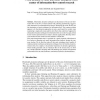Free Online Productivity Tools
i2Speak
i2Symbol
i2OCR
iTex2Img
iWeb2Print
iWeb2Shot
i2Type
iPdf2Split
iPdf2Merge
i2Bopomofo
i2Arabic
i2Style
i2Image
i2PDF
iLatex2Rtf
Sci2ools
ERSHOV
2009
Springer
2009
Springer
From Dynamic to Static and Back: Riding the Roller Coaster of Information-Flow Control Research
Abstract. Historically, dynamic techniques are the pioneers of the area of information flow in the 70's. In their seminal work, Denning and Denning suggest a static alternative for information-flow analysis. Following this work, the 90's see the domination of static techniques for information flow. The common wisdom appears to be that dynamic approaches are not a good match for security since monitoring a single path misses public side effects that could have happened in other paths. Dynamic techniques for information flow are on the rise again, driven by the need for permissiveness in today's dynamic applications. But they still involve nontrivial static checks for leaks related to control flow. This paper demonstrates that it is possible for a purely dynamic enforcement to be as secure as Denning-style static information-flow analysis, despite the common wisdom. We do have the trade-off that static techniques have benefits of reducing runtime overhead, and dynamic tech...
Dynamic Techniques | ERSHOV 2009 | Information Flow | Information-flow Analysis | Theoretical Computer Science |
| Added | 17 Feb 2011 |
| Updated | 17 Feb 2011 |
| Type | Journal |
| Year | 2009 |
| Where | ERSHOV |
| Authors | Andrei Sabelfeld, Alejandro Russo |
Comments (0)

